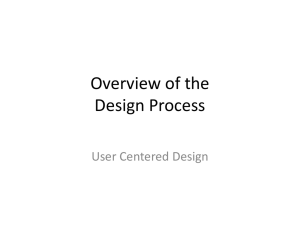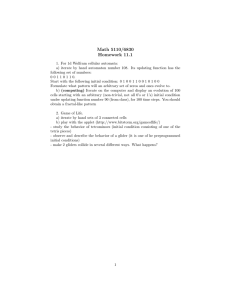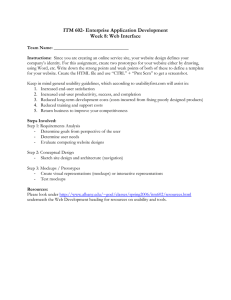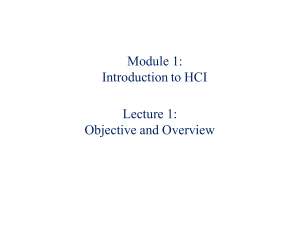Conceptual & Mental Models
advertisement
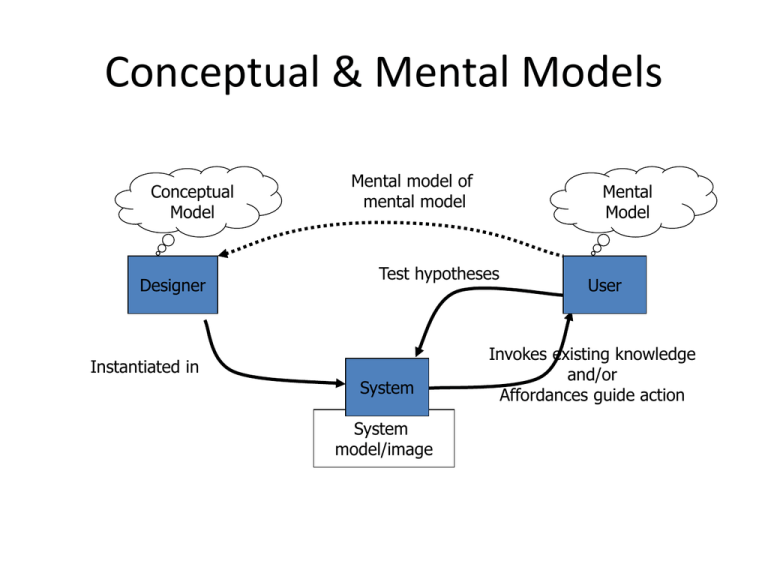
Conceptual & Mental Models Conceptual Model Designer Mental model of mental model Mental Model Test hypotheses Instantiated in System System model/image User Invokes existing knowledge and/or Affordances guide action Mental models • User’s understanding (internal rep) of a system – How to use the system (what to do next) (functional knowledge) – What to do with unfamiliar systems or unexpected situations (how the system works) (Structural knowledge) • People make inferences using mental models of how to carry out tasks • Involves unconscious and conscious processes, where images and analogies are activated The UI Design Process User-Centered Design This material has been developed by Georgia Tech HCI faculty, and continues to evolve. Contributors include Gregory Abowd, Jim Foley, Diane Gromala, Elizabeth Mynatt, Jeff Pierce, Colin Potts, Chris Shaw, John Stasko, and Bruce Walker. Comments directed to foley@cc.gatech.edu are encouraged. Permission is granted to use with acknowledgement for non-profit purposes. Last revision: January 2004. The Tao of UCD DESIGN USE & EVALUATE IMPLEMENT UCD Nine-Step Overview Req. Definition 1. Understand constraints/context 2. User analysis 2. Task analysis 4. Function allocation 5. Define usability criteria 6. Design UI - including help and documentation 7. Build & test prototypes 8. Build & test the real application 9. Release, update and maintain 1. Define the Context • Context: the “type” of uses, applications – – – – – Life critical systems, applications Industrial, commercial, military, scientific, consumer Office, home, entertainment Exploratory, creative, cooperative General functionality of system • Pragmatics – Costs and schedule – Technical constraints - equipment, OS, memory, disk • Customer - makes the buying decision (not the user) – …Design Impacts?… 2. Describe the User • Physical attributes (age, gender, size, reach, visual angles, etc…) • Physical work places (table height, sound levels, lighting, software version…) • Perceptual abilities (hearing, vision, heat sensitivity…) • Cognitive abilities (memory span, reading level, musical training, math…) • Personality and social traits (likes, dislikes, preferences, patience…) • Cultural and international diversity (languages, dialog box flow, symbols…) • Special populations, (dis)abilities Design Implications Population Implications Users 16-80 yrs Range of text sizes Range of grip strength Some French speakers Multilingual interface Astronaut users Extensive training available Military context Aesthetics less of an issue Ruggedness is critical 3. Task Analysis • • • • Talk to and observe users (NOT customers) List each and every TASK Break tasks down into STEPS ABSTRACT into standard tasks 4. Function Allocation • Consider the whole system! • Decide who or what is best suited to perform each task (or each step) – e.g., system remembers login id, and reminds the user, but user remembers the password • Allocation constraints: Effectiveness; Cognitive/affective; Cost; Mandatory …Don’t forget the design implications!… 5. Define Usability Criteria – Task X should take less than Z seconds – New user should be able to edit document within 30 minutes – Error rates should be less than X% – User satisfaction measurements – Workload measures – Accuracy measures 6. Design the UI • Summary of the components and their basic design • Cross-check with any Requirements Documents; Human Factors refs; Hardware specs; Budgets; Laws (ADA); etc. • Ensure that the system will support the design and comply with constraints • (Verification and Validation, in the language of software engineering) Design • Design is driven by requirements What the artifact is for … Not how it is to be implemented • Design represents the artifact – Storyboards or screen sketches – Task flow diagrams - more detailed than in task analysis stage – Executable prototypes • Representations should always simplify Get Informal Feedback ASAP! • Present prototype to users • Do a quick questionnaire • Watch (quietly) as user struggles with your terrible design Design fixation • Keep an open mind • Don’t get wedded to an idea • Don’t let design review become about whose idea wins Honor the truth. People come first not your ego Iterate on Design • Redesign system – In light of initial user impressions – Pay attention to common complaints • Be prepared to abandon bad ideas!! • It’s just an idea, not a measure of your worth! Formative Evaluation Techniques • Use while “forming” the design • Apply design principles - heuristic evaluation – Consistency, don’t set the user up, etc etc … • Apply design rules / standards / style guides – Java look and feel, Mac look and feel, etc • Cognitive walkthrough • Key-stroke level model, NGOMSL analyses 7. Build & Test Prototypes • “Informed Brainstorming” • RAPIDLY mock up the user interfaces for testing with real people • Pen and paper or whiteboard to start • Iterate, iterate, iterate!! • Increasingly functional & closer to final reality • List audio & visual details at same levels of detail in the prototypes – (i.e. don’t forget either of them) 7. Prototyping • • • • • Storyboards Paper simulations of application Wizard of Oz experiment Prototyping tools Cheap! 7. Summative Evaluation Techniques • Empirical / laboratory evaluation – Discount usability - can be very effective, using fewer subjects, more rapid results • Expert review • Field study • Client review 8. Build & Test the Real App. • Repeat cycles of testing and reworking the system, subject to cost/time constraints • Focus on Functionality First ! • Plan for several versions during development 9. Release, Update & Maintain • In-the-field feedback, telemetry, user data, logs, surveys, etc. • Analyze and make iterative redesign/test recommendations • Updates and maintenance plan as part of the design! – (design it so it can be fixed or updated) Focusing Your Efforts • There are real-world constraints • Cutting out steps is not the way to economize! • Optimize the efficiency of each step Quotable Quotes “The secret to having good ideas is to have many ideas” -- Bill Buxton “You’ve got 100,000 bad drawings inside you. You’re here at art school to get them out.” -- Chuck Jones Design takes practice!! Design • How do we come up with new (good) designs for interactive systems? • Why is it so difficult? Idea Creation How do we create and develop new interface ideas and designs? • Borrow from other • Ideas come from fields – Imagination – Analogy – Observation of current practice – Observation of current systems – – – – – Animation Theatre Information displays Architecture ... » … metaphor Design Exercise
